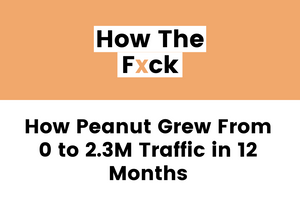2.3M new visitors in under 12 months?! Here's exactly how Peanut did it.
I interviewed Dimitris Drakatos in late 2021 for this episode. He’d been at Peanut App for almost exactly one year as their first SEO lead—and their traffic growth was exponential.
In just seven months, Peanut’s search clicks had gone from 400 to 1.8 million per month. Within 12 months they reach 2.3M. This kind of impressive growth is almost unheard of, which is why I reached out to him to get the lowdown on how his team did it.
From implementing a similar strategy with my own clients, I know how hard these results are to achieve, particularly in competitive niches.
The fundamentals we learn from Dimitris’ story are a solid foundation for building your own SEO machine, but of course, the opportunity size relies on you having the right mix of resources, addressable keyword volumes, and competitive industry dynamics.
Let's deep dive into this case study.
Expect to learn:
- Why building a defensible SEO moat was top of mind for Peanut
- The volume of content published—was it 10 articles per month? 50? 100?
- Why Dimitris didn't focus at all on backlink building
- Were website developers needed?
- The three buckets of keyword types you choose strategically
- Why avoiding cannibalization is so critical when producing content at-scale
- What 7 points are KEY to ensuring content remains a high-quality
Sign up below for access.
Words of Warning: A quick look at Ahrefs for Peanut App reveals their top 5 pages including page one SERP spots for keywords like ‘unique girl names’ which has 240k global monthly search volume. Brilliant and well-aligned for Peanut, but don’t expect much volume in the B2B SaaS space.
Let’s dig in.
What were Peanut’s goals?
To understand if this strategy makes sense for you, it’s important to understand where Peanut was at in its startup stage and what they were hoping to achieve.
In December 2019, Peanut announced that its user base had grown 60 percent since December, from 1 million to 1.6 million users. In May 2020, they raised their Series A investment round of $12M.
Those of you who’ve been through this startup phase will know that with a fresh cash injection from high-profile VC firms, you’re expected to grow, quickly. You’ll have shifted quickly to having less time, and more cash—which means you’re ready to spend, spend, spend to be even more desirable before your Series B round comes along.
Peanut was in exactly this situation. They wanted to enter into their Series B with a highly defensible position, which meant closing the SEO gap with their competitors rapidly.
Here’s some more context:
- The website was currently not conversion rate optimized. It had the basics about Peanut but was a customer acquisition machine.
- Growth till now came from word of mouth and some paid campaigns.
The main goal was to build an organic acquisition machine, which meant building up organic, relevant traffic to the site. This traffic would help them get data to understand visitor activity so they could begin CRO, drive app installs, and more active users.
No one expected such incredible results. But, when they came, Peanut doubled down.
What was the strategy?
Let's break it down
In a nutshell, Dimitris and his team published 100 blog posts per month. He focused on three silos of keywords (low-hanging fruit, topic clusters, and branded keywords), building out content using SEO best practices in interlinking, keyword optimization, and avoiding cannibalization.
Let's dive in:


